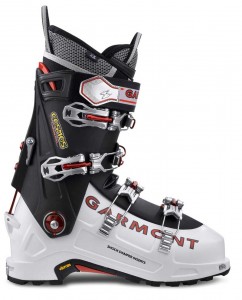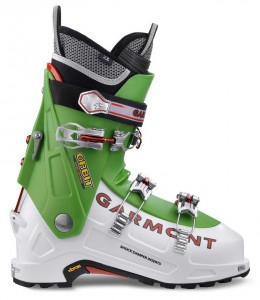Most of the features listed in the press release indicate this is the sort of progression in design and functionality you would expect. Garmont did a bang-up job of recognizing early on that to pull more people out-of-bounds they had to provide downhill performance on par with resort boots. Weight was a key component to acceptance of these boots, as exhibited by their Delerium.
With the introduction of the Radium though, Garmont signaled they hadn’t abandoned core turn earning skiers and they up the ante with the Cosmos and Orbit in the Power-Lite series. Borrowing elements from their welter weight Alpine Lite series, the shells will be built from Grilamid, a thinner and lighter but stronger PU based plastic. Overall stiffness of the shell is rated at 125, meaning it isn’t the stiffest boot on the market, but it’s hardly soft. The EZ Fit Liners will come pre-shaped to placate those who insist on their boots fitting well out of the box without the benefit of thermo-molding. The liners remain moldable for those who know better.
Weight is in the mid-range, not so light that it compromises confidence, but light enough that it saves energy on the climb.
Where these boots really improve the touring side of the equation though is with a cuff that delivers a 60° range of motion in walk mode. Key to this claim is a patent-pending dual-hinge system that allows the cuff and locking bar to both pivot, allowing uninhibited motion throughout the full 60°. All other boots provide increasing resistance as you approach their limits.
Prior to Garmont’s new Power-Lite series, if you wanted that much range of motion in the cuff for touring you needed to use a rando-race boot and accept some loss of downhill control. I can’t wait to see this cuff system proved out and get incorporated in the Voodoo, Prophet, and Kenai.
© 2012



3 comments
2 pings
Hey Craig –
Thanks for putting this up as the southern snow drought continues. Hope you folk get some soon.
Interesting stuff. Glad to see more options coming out. I think one factor that needs to be talked about more in the range of motion area is ease of motion.
The system Garmont and Scarpa have for tour mode/ski mode is a fixed metal bar that slides in and out of the plastic housing and then locks down. Even brand new there’s significant resistance. With the external lever lock system (Scarpa F1, Dynafit TLT, Sportiva etc) there isn’t a flat metal bar waiting to get mucked up and resist moving with each stride. The internal lock system looks more elegant but the external one is the real deal for getting closer to friction free. Personally I would sacrifice a little range to get less friction.
Just a thought. Thanks again. Look forward to seeing these babies come out.
Author
snowy,
Ah, yes, agree on the ease of motion. That is what is so exciting about these PowerLite boots. Paul Parker explained to me – as best as one can over the phone without diagrams and such – that this new system has dual pivots which eliminates the resistance you’re talking about.
I did not hype that too much in this article as it remains to be seen and experienced. It is a good sign that manufacturers are waking up the the desire for this.
It is part of why the rando race scene is important. Racing always stretches limits and boundaries and things are learned that can be applied to everyone. There are tons of examples, but I’ll throw one out that everyone enjoys these days…fuel injected cars. Only race cars had fuel injection in the 60s and 70s. Now every car uses fuel injection. It’s more reliable, gives better mileage, better acceleration, etcetera.
Will be interesting to see P. Parker’s vision comes true. Hope so. I saw another site list the Orbit at 1345grams each. If they could come close to this for tele it would be a big deal, combined with light bindings like the TTS. This way sport might not hemorrhage blood to AT as much as it is now.
I’ve often thought of the racing analogy too. Sometimes it takes doing something far flung and artificial (racing) to open up new ground for normal life (touring). The irony with this is the effects tele racing and rando racing had were so divergent. Tele racers rave about high performance and railing into corners on ice and got boots and bindings that do just that. But with tele races having only a nominal up component the rigs got heavier and heavier. Rando races are won on the up climb and voila! Those racers asked manufacturers for lighter and lighter stuff. There’s probably a lot of holes in that simplistic history, but I think a lot of it rings true.
Sending snow vibes your way, Craig!
Joe
[…] Preview: Garmont’s PowerLite AT Boot Series | EarnYourTurnsFind Hiking Boots reviews at Buzzillions including 7 reviews of Garmont … Michael D. Compare Prices. Search eBay.com for Garmont Sitka XCR Men’s Shoes … […]
[…] Related Posts: Preview: Garmont’s PowerLite Series AT Boots […]